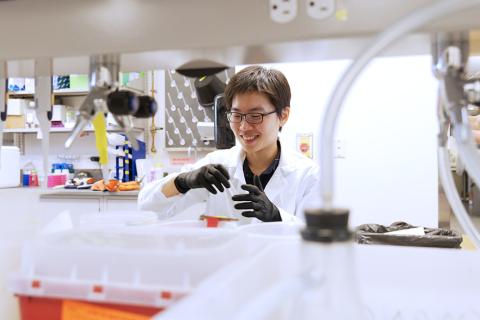Postdocs push the boundaries of what is possible in a variety of fields. However, despite their significant role in academic institutions, there are many misconceptions surrounding the role of a postdoc.
Dive into the world of postdocs with our spotlight video interviews featuring Sam Gowland, Avery Davis Bell, Zita Hüsing, Ida Su, and Nicole Hellessey as they share their unique experiences and insights on what it truly means to be a postdoc.
At any given time, Georgia Tech has 350 to 400 postdoctoral scholars (postdocs) making valuable contributions to research across the globe, with most right here on our Atlanta campus engaged in research, mentorship, and teaching.
Postdocs push the boundaries of what is possible in a variety of fields. However, despite their significant role in academic institutions, there are many misconceptions surrounding the role of a postdoc.
Daniel Vallejo, postdoctoral scholar at Tech, and Karena Nguyen, assistant director in the Office of Postdoctoral Services, weigh in on common myths about postdocs versus reality.
Myth #1: Postdocs are "super" grad students.
Reality: Graduate students undergo structured training and coursework, with the end goal of producing a thesis or dissertation. Graduate students primarily dedicate their effort towards degree completion under the guidance of their academic supervisor and dissertation committee.
In contrast, the National Postdoctoral Association defines postdocs as “individuals in a defined period of mentored training following the achievement of their terminal degrees,” typically a Ph.D. Therefore, postdocs operate at a different level of independence and have a variety of roles and goals. For example, postdocs may initiate and lead research projects, teach courses, mentor undergraduate and graduate students, secure funding through fellowship applications, and collaborate with other experts in addition to publishing research.
Myth #2: Only STEM fields have postdocs.
Reality: Postdoctoral positions exist in many fields, including science, technology, engineering, mathematics (STEM), humanities, and social sciences. At Tech, postdocs work in all six colleges and a number of research centers.
Myth #3: Postdocs only conduct research.
Reality: The role of a postdoc extends far beyond research. Postdocs at Tech actively engage in mentorship, shaping the next generation of scholars. Tech postdocs can also be found in the classroom teaching undergraduate students. Postdocs also tend to be very active outside their official duties, and often can be found volunteering to provide academic or community service.
Myth #4: Postdocs only become faculty members.
Reality: While becoming a faculty member is a viable and commonly pursued career path, a postdoctoral position provides additional training that opens doors to a multitude of career fields. Postdocs can find opportunities in academia, industry, government, or nonprofit organizations, and the postdoc experience is often pivotal for transitioning into these exciting careers.
Myth #5: Being a postdoc isn't a "real" job.
Reality: Postdoctoral positions are temporary and provide additional training for individuals to pursue a desired career path. It is an enriching employment opportunity and allows individuals to apply the skills honed during their Ph.D. to different fields or broaden their skillset through internal, domestic, and international collaborations. There are opportunities for creativity, exploration, growth, and independence.
The Postdoc Visibility Project is a collaboration between the Office of Graduate Education and Postdoctoral Services, the Department of Chemistry and Biochemistry, and Tech’s postdocs. Our goal is to highlight the contributions of postdocs to the research enterprise, humanize the postdoc experience, and connect postdocs to each other. To achieve this, we will share three spotlight articles and accompanying video interviews throughout the Spring 2024 semester.
This work is supported in part by the National Sciences Foundation Mathematical and Physical Sciences divisions ASCEND program under grant award number CHE-2138107.
Any opinions, findings, and conclusions or recommendations expressed in this material are those of the author(s) and do not necessarily reflect the views of the National Science Foundation.
